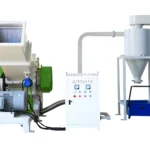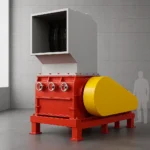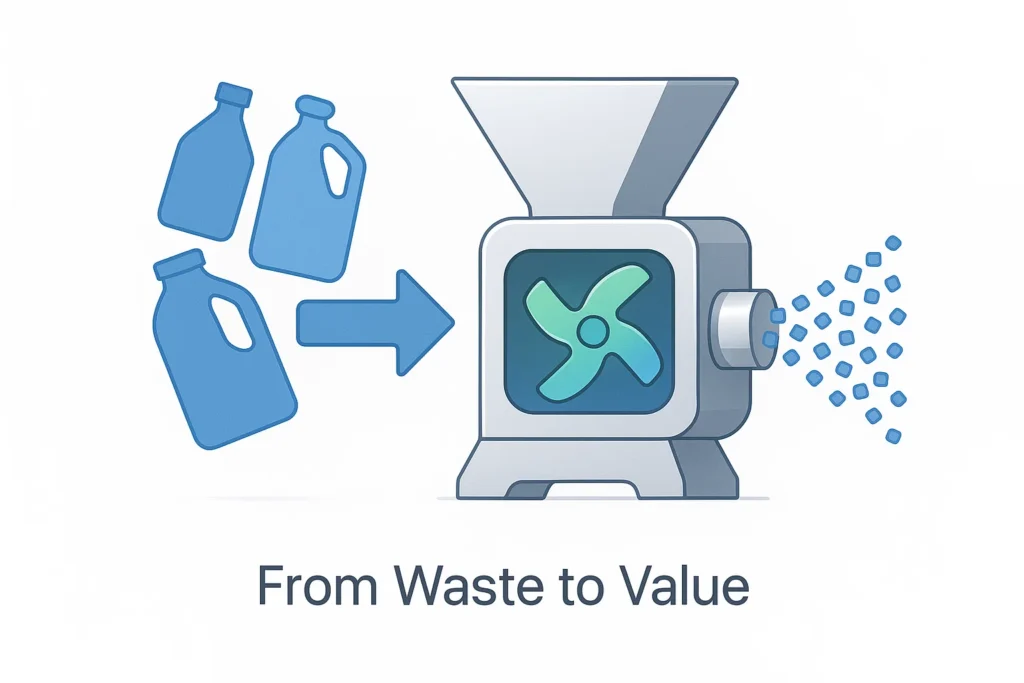Everything You Need to Know About Plastic Reduction Technology
In the world of plastic recycling, efficient reduction technology is the key to sustainable material reuse. The plastic granulator plays a central role in this. This powerful machine converts plastic waste into uniform granulate particles that can be reused in production processes such as extrusion or injection molding.
As a leading supplier of recycling machines, Energycle provides this guide to give you insight into how a operates, which components are crucial, and what to consider when choosing the right machine. kunststofgranulator What is a Plastic Granulator?.
A plastic granulator is a machine that reduces larger plastic pieces – such as injection molding waste, pipes, bottles, or technical parts – into smaller, uniform particles (granulate or "regrind"). These particles can be reused, reducing waste and lowering dependence on new plastic.
Key Components of a Granulator.
Hopper (trechter):
- Trechter (hopper): Input Point for Plastic Waste. Can be filled manually or automatically.
- Cutting Chamber: The actual reduction takes place via a rotating rotor and stationary knives.
- Rotor & Knives: The rotor contains hardened knives that rotate at high speed. Together with fixed knives, a shearing action is created that cuts the plastic.
- Sieve: Only particles small enough to pass through the sieve openings are allowed to pass. The sieve determines the final size of the granulate (e.g., 10–100 mm).
- Drive System: A powerful motor (often 22–110 kW) drives the rotor. Energycle uses efficient V-belt drive systems.
- Discharge and Collection System: The granulate is collected in a bin or pneumatically transported to the next processing stage.
How Does the Reduction Process Work?
- Input: Plastic waste is fed into the hopper.
- Cutting: The rotor rotates and cuts the material along with stationary blades.
- Sieve Selection: Only well-reduced particles pass through the sieve.
- Output: The granulate is discharged and is ready for reuse.
Application Areas
Plastic granulators are widely used in applications such as:
- Plastic Production: Recycling of internal waste (sprues, failed parts).
- Automotive: Recycling of plastic components and interior panels.
- Packaging: Efficiently reduce bottles, films, and trays.
- Construction: Reduce PVC pipes, windows, and profiles.
- Electronics: Reuse plastic enclosures from e-waste.
What Factors Affect Performance?
| Variable | Effect on Capacity | Effect on Quality |
|---|---|---|
| High rotor speed | Increased output, more dust with brittle plastic | Faster processing |
| Low rotor speed | Decreased output | Finer, more uniform cut |
| Small screen openings | Finer granulate, lower capacity | Ideal for precise applications |
| Dull blades | Poor cutting result | More dust, higher energy consumption |
What to Consider When Buying a Granulator?
- Type of Plastic: Choose between rigid (ABS, PS) or flexible (PE, PP) materials and select the appropriate rotor and blade geometry.
- Capacity: Match the motor power and feed opening to your production volume.
- Desired particle size: Energycle offers sieve openings ranging from 10 mm to 100 mm.
- Installation Space: Check machine dimensions and integration options.
- Maintenance Ease: Our models provide hydraulic access to the cutting chamber.
Maintenance and Safety
- Regular knife sharpening prevents quality loss and energy consumption.
- Sieve Inspection prevents blockages and ensures consistent output.
- Lubrication of bearings and control of V-belts extend the lifespan.
- Safety features such as emergency stops, interlocks, and protective caps are standard with Energycle.
Frequently Asked Questions (FAQ)
Which plastics can be processed?
PE, PP, PET, PVC, PS, ABS, HDPE, and other thermoplastics – depending on machine configuration.
What is the difference between a shredder and a granulator?
A shredder reduces coarse and slow materials, while a granulator processes fine and fast materials. Both are often used in series.
How often should the blades be replaced?
Depending on the material and volume. Regularly check for dullness or increased power consumption.
Can wet plastics be processed?
Some Energycle models are suitable for wet material, such as after washing.
Conclusion: Sustainable, Efficient, and Flexible
A plastic granulator from provides this guide to give you insight into how a is more than a machine; it's an investment in circular production, cost savings, and business sustainability. Our models combine power, precision, and ease of use, supported by technical experts worldwide.
Visit our website for technical specifications or contact us for personal advice:
standard plastic granulators


 Granulator for Recycling WPC Material (Wood-Plastic Composite)
Granulator for Recycling WPC Material (Wood-Plastic Composite) Granulators for Hard Plastics
Granulators for Hard Plastics